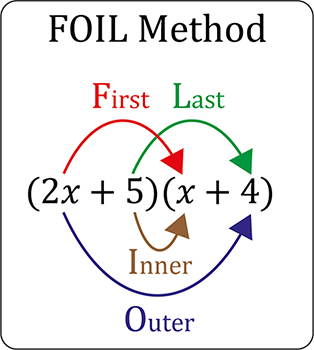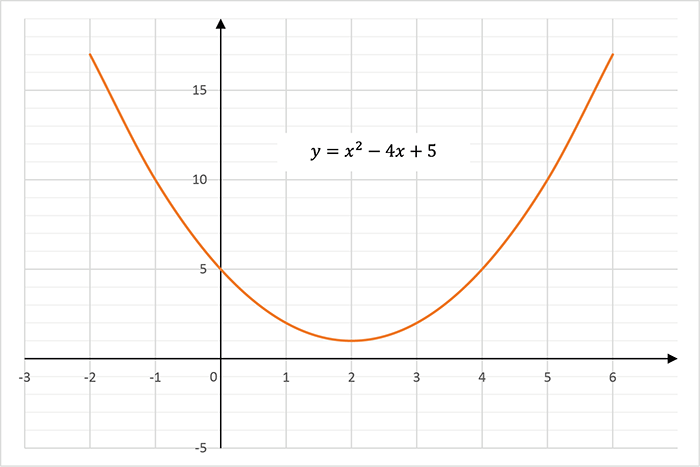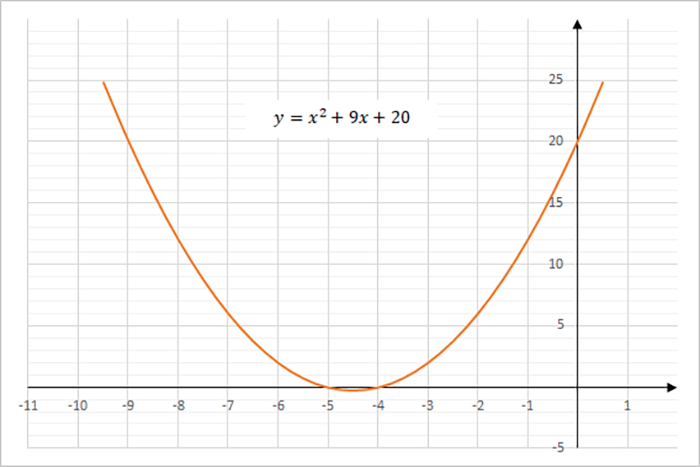Simultaneous and Quadratic Equations
Continued from: Introduction to AlgebraOur page Introduction to Algebra explains how to solve straightforward equations with basic algebra.
This page discusses more complex equations, including those involving fractions, and two particular problems that you may encounter: simultaneous equations and quadratic equations.
Most importantly, it makes clear that these equations, like others, conform to rules, and that you can still manipulate them, as long as you remember to do the same thing to both sides of the equation.
Brackets in Algebra
In algebraic equations, you will often come across terms inside brackets (parentheses). To solve the equation, you may need to expand the brackets. This means that we need to work through the expression and remove the brackets in a logical way, according to some rules.
If you have only a single set of brackets in your equation, the process is straightforward. For example:
$$4(x−2) = 18$$In this case, everything inside the brackets on the left hand side of the equation is multiplied by 4. First, expand the brackets term by term:
$$4x – 8 = 18$$Now you can solve the equation for \(x\). Next, add 8 to each side:
$$4x = 26$$Finally divide each side by 4:
$$x = 6.5$$If your equation has two sets of brackets (or more), which need to be multiplied together, then the process is more complicated, but follows a logical set of rules.
For example, expand the expression:
$$(2x + 5)(x + 4) = 0$$On the left hand side of the equation, we need to multiply (2\(x\) + 5) by (\(x\) + 4). Each set of brackets contains more than one term. It is not simply a case of multiplying a set of brackets by a coefficient, as in the previous example, where you multiplied the whole bracket by 4.
In this case, you need to multiply each term in the first bracket by each term in the second bracket and add them all together, that is, multiply \(x\) by \(x\), \(x\) by 4, then \(x\) by 5, then 4 by 5. It does seem rather complicated, so you can use a method known as ‘FOIL’ to help.

FOIL stands for First Outer Inner Last.
FIRST: 2\(x\) × \(x\) = 2\(x\)2
OUTSIDE: 2\(x\) × 4 = 8\(x\)
INSIDE: 5 × \(x\) = 5\(x\)
LAST: 5 × 4 = 20
The next step is to add these together:
2\(x\)2 + 8\(x\) + 5\(x\) + 20 is the same as 2\(x\)2 + 13\(x\) + 20.
So the original equation (2\(x\) + 5)(\(x\) + 4) = 0 becomes:
$$2x^2 + 13x + 20 = 0$$This type of equation is known as a quadratic equation. There is more on this below.
Equations with Fractions
Equations with fractions look a bit daunting, but there is a simple trick to make them easier to solve.
Cross-multiplication involves removing the fractions by multiplying both sides by each denominator, in turn. For more about working with fractions, see our page on Fractions.
Worked Example
$$\frac{2+x}{3}=\frac{9+x}{5}$$
To remove the fractions, multiply both sides of the equation by each denominator (3 and 5) in turn.
Start by multiplying each side by 3:
On the left, the two 3s cancel out, leaving 2 + \(x\).
On the right, expand the brackets in the numerator to make 27 + 3\(x\)
Now multiply both sides by 5. Again, the two 5s will cancel out on the right, and you will end up with:
$$5(2 + x) = 27 + 3x$$ $$10 + 5x = 27 + 3x$$Rearrange the equation so that terms containing \(x\) are on the left and terms containing only numbers are on the right. First, subtract 10 from each side:
$$5x = 17 + 3x$$Then subtract 3\(x\) from each side to get all the \(x\) values on the left, and you end up with:
$$2x = 17$$Finally, dividing both sides by 2 gives you the value of \(x\):
$$x = 8.5$$Note that \(x\) does not always have to be a whole number.
Simultaneous Equations
So far all of the examples have contained only one ‘unknown’ variable, \(x\). We can solve these equations using algebra to find the value of \(x\). If you have one unknown, you only need one equation to solve to get the answer.
However, what happens if you have an equation such as \(y\) = 4\(x\) + 5, where there are two unknowns, \(x\) and \(y\)?
You might even come across a more complex equation in which you have three unknowns, \(x\), \(y\) and \(z\).
To solve these, the rule is that you need the same number of equations as you have unknowns. All of the equations have to be true for all of the unknowns. This means you need two equations for two unknowns, three equations for three unknowns, and so on.
Simultaneous equations are a set of two equations, both involving the same unknown variables, both of which are true. They are referred to as simultaneous because they are solved together.
Simultaneous equations are sometimes indicated by a long curly bracket to link them together.
The method for solving simultaneous equations with variable \(x\) and \(y\) is:
-
First rearrange one equation to obtain an expression or a value for \(x\). The rearranged equation may be \(x\) = a number, or it may be an expression where \(x\) = a function of \(y\) (i.e. \(y\) still exists as an unknown in the equation). You may see this written as \(x\) =ƒ(\(y\)), which simply means ‘\(x\) is a function of \(y\)’.
Once you have a value or an expression for \(x\), then you can substitute it into the other equation to find the value of \(y\). This new equation will have only one unknown, \(y\).
- Finally, if your answer \(x\) = ? from step (1) contains ‘\(y\)’, then you can substitute your value of \(y\) from step (2) into your expression for \(x\), to find the value of \(x\).
Worked Example 1: When x can be solved as a value in Step 1.
$$\biggl\{\begin{eqnarray} 2x = 6 \quad \; \; \; \\ y = 4x + 5 \end{eqnarray}$$If 2\(x\) = 6, then \(\boldsymbol{x}\) = 3.
By substituting 3 for \(x\) in the second equation, you can solve it to find out what \(y\) is.
$$y = (4 \times 3) + 5 = 17.$$ $$\boldsymbol{y = 17}$$
Worked Example 2: When Step 1 gives \(x = ƒ(y)\)
$$\biggl\{\begin{eqnarray} x - y = 1 \quad \; \; \\ 2x + 3y = 27 \end{eqnarray}$$Step 1: If \(x\) − \(y\) = 1, then \(x\) = 1 + \(y\)
Step 2: Substituting this into the second equation gives 2(1 + \(y\)) + 3\(y\) = 27
Expanding the brackets gives 2 + 2\(y\) + 3\(y\) = 27
Then 2 + 5\(y\) = 27
So 5\(y\) = 25, giving the solution \(\boldsymbol{y}\) = 5.
Step 3: We know that \(x\) – \(y\) = 1, therefore \(\boldsymbol{x}\) = 6.
Quadratic Equations
An equation that takes the form \(ax^2 + bx + c = 0\) is called a quadratic equation.
\(\boldsymbol{a}\), \(\boldsymbol{b}\) and \(\boldsymbol{c}\) are all numbers, and in any given equation may all be the same or may be different. They can also be negative or positive.
Examples of quadratic equations are:
\(\boldsymbol{2x^2 + 5x + 10 = 0}\). In this equation, \(a\) = 2, \(b\) = 5 and \(c\) = 10.
\(\boldsymbol{3x^2 - 3x + 9 = 0}\). In this equation, \(a\) = 3, \(b\) = -3 and \(c\) = 9.
-
\(\boldsymbol{52x^2 + x}\) −\(\boldsymbol{45 = 0}\). In this equation, \(a\) = 52, \(b\) = 1 and \(c\) = −45.
Parabolic Curves and Quadratic Equations
Quadratic equations are very important in mathematics and science. They are the mathematical ‘description’ of a parabolic curve (parabola). For more on parabolas and other curved shapes known as conical sections, see our page on circles, ellipses, parabolas and hyperbolas. The values of \(a\), \(b\) and \(c\) in the quadratic equation describe the shape of the curve and where it is positioned within a set of Cartesian coordinates (x and y axes). For more, see our page on Cartesian coordinates.
A parabola drawn from a quadratic equation where \(a\) = 1, \(b\) = −4 and \(c\) = 5 looks like this:

There are several different ways to solve these equations:
1. By Factorising
In mathematics, factors are things that are multiplied together. Factorisation is a process used to create two factors from the quadratic expression that can be multiplied together. These factors are sets of brackets with a simple linear expression containing \(x\) inside each one.
You make a quadratic equation by multiplying out two expressions in brackets (\(x\) + a number)(\(x\) + another number). This means that every one that has a solution can be written in this two-bracket form.
This is the opposite of the FOIL method for expanding brackets that is described above. Expanding two sets of brackets multiplied together gives:
$$\boldsymbol{(x + m)(x + n) = x^2 + (m + n)x + mn}$$This means that when you have an equation in the form \(x^2 + bx + c\), you are looking for two numbers such that when they are multiplied you get \(c\), and when they are added you get \(b\). You will normally be able to see straight away if these exist as whole numbers.
Only the simplest quadratic equations can be factorised easily. If you haven’t been able to solve it by factorisation after a couple of minutes, it’s best to try a different method.
Worked Example
$$\boldsymbol{x^2 + 9x +20 = 0}$$
You know that 4 × 5 = 20, and 4 + 5 = 9.
The two brackets are therefore (\(x\) + 4)(\(x\) + 5).
This expression must equal zero, so either \(x\) + 4 = 0 or \(x\) + 5 = 0.
The two solutions of the equation are \(\boldsymbol {x}\) = −4 and \(\boldsymbol {x}\) = −5.
Why are there two solutions to a quadratic equation?
Because the graph is in the form of a parabola.
Below is the graph of the equation used in the example above \(y\) = \(x\)2 + 9\(x\) + 20.
The two values of \(x\) are known as the roots of the equation. These are the values of \(x\) when \(y\) = 0. On the graph, \(y\) = 0 at the x-axis. The points \(x\) = −4 and \(x\) = −5 are therefore where the curve of the equation crosses the x-axis. The minimum value of \(y\) (the lowest point of the curve) occurs between \(x\) = −4 and \(x\) = −5. It is just possible to see the curve dipping below the x-axis on this graph.
Looking at the equation again, when \(x\) = 0, then \(y\) = 20. On the graph, we can see that the curve crosses the y-axis (\(x\) = 0) at +20. This is known as the y-intercept and is always the value of \(c\) in a quadratic equation.

2. Using a Formula
If the two factors are not obvious, the next step is to use a formula. All quadratic equations that can be solved will give an answer using the formula:
$$\large x = \frac {-b \pm \sqrt{b^2 - 4ac}}{2a}$$In this case, \(a\) is the coefficient of \(x\)2, \(b\) of \(x\), and \(c\) is the number at the end when the equation is in the form \(ax\)2 + \(bx\) + \(c\) = 0.
Any equation which has only terms with \(x\)2, \(x\) and numbers can be turned into the form \(ax\)2 + \(bx\) + \(c\) = 0, and then solved using the formula.
Because you can have \(b\) plus or minus the square root, quadratic equations always have two solutions, as shown in the info box above. They are called the roots of the equation, and the reason for this is more obvious when we look at the formula \((\pm\sqrt)\).
It is important to remember that some quadratic equations do not have a ‘real’ answer.
For example, if \(b\)2 − 4\(ac\) is negative, then there will be no real answer, because you cannot have a square root of a minus number, except in the form of an imaginary number (there is more about imaginary numbers on our page on special numbers and concepts).
3.Completing the Square
If your quadratic equation cannot be factorised, then an alternative to using the formula is a method called completing the square. It is possibly the most tricky of the methods to understand. It requires you to rearrange the equation so that it becomes a ‘perfect square trinomial’ (a trinomial is a mathematical expression with three terms).
That sounds very complicated, but it is just ‘maths-speak’ for saying that you can use this method to convert a quadratic equation from one that can’t be factorised into one that can be factorised, and you can find the solution by calculating its square root.
This method only works for \(ax\)2 + \(bx\) + \(c\) = 0 when \(a\) = 1. If \(b\) is even, then even better.
To solve the equation, we need to introduce another expression:
$$(x + \frac b2)^2 +c$$This expression can be expanded to give
$$x^2 + bx + \left( \frac b2 \right)^2 +c$$This is the same as the original quadratic equation, but with an extra term \((\frac b2)^2\)
The original equation can therefore be re-written as the new expression, minus the extra term:
$$(x + \frac b2)^2 - \left( \frac b2 \right) ^2 + c = 0$$Rearranging this new equation gives
$$(x + \frac b2)^2 = -c+\left( \frac b2 \right) ^2$$This can be solved by taking the square root of each side.
The following worked example makes this method easier to understand:
Find the values of \(\boldsymbol{x}\) when \(\boldsymbol{x}\)2 − 18\(\boldsymbol{x}\) + 72 = 0
First you complete the square by adding \((\frac b2)^2\) to each side.
In this case this extra term is \((18 ÷ 2)^2 = 9^2 = 81\)
$$x^2 - 18x + 81 = -72 + 81$$Next you factorise the left hand side:
$$(x - 9)(x - 9) = 9$$This is the same as
$$(x - 9)^2 = 9$$You can see that by using this method, the left hand side of the original equation has been converted into a perfect square trinomial. This can be solved by taking the roots:
$$x - 9 = \pm \sqrt{9}$$ $$x = 9 \pm 3$$Conclusion
Having read this page and followed the examples, you should now be feeling more confident about your ability to handle even quite complex equations.
Just remember the golden rule:
Always do the same thing to each side of the equation
If you do, then you will be fine.
Continue to:
Simple Statistical Analysis
Set Theory
See also:
Introduction to Trigonometry
Probability
BODMAS
